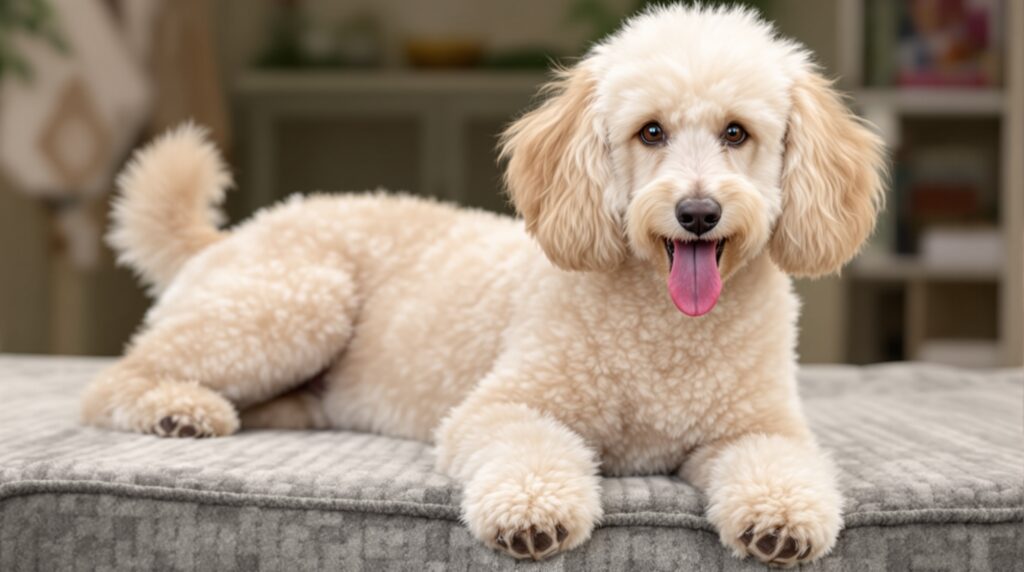Poodles rank among the most intelligent dog breeds. They need activities that keep their minds busy.
If you leave a poodle—standard, miniature, or toy—unstimulated, boredom and restlessness creep in fast. Training games challenge your poodle’s brain and body, while also bringing you closer together.
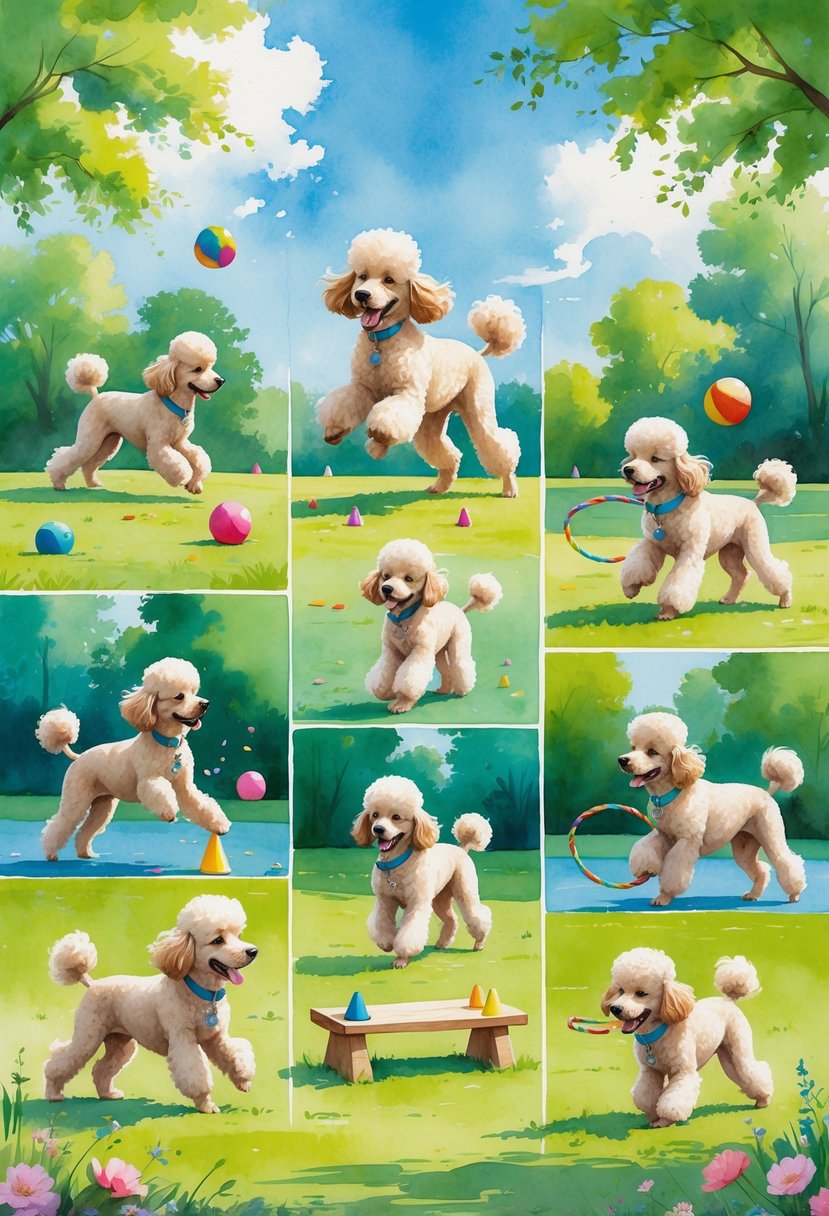
You can turn playtime into learning by adding activities that test memory, focus, and problem-solving. From hide-and-seek to scent games, these ideas keep your poodle sharp.
Each game is easy to set up and taps into your poodle’s natural curiosity. They’re fun, quick to play, and match a poodle’s energy.
Key Takeaways
- Poodles need training games to stay mentally sharp and active
- Simple activities can build skills and prevent boredom
- Play-based training strengthens your bond with your dog
Why Poodles Need Engaging Training Games
Poodles have sharp minds and crave activities that work both their body and brain. When you offer structured games, you help prevent boredom and cut down on unwanted behaviors.
The Importance of Mental Stimulation
Your poodle needs more than just exercise. Walks and runs help, but mental stimulation is what truly satisfies them.
Games that make your dog think, like puzzles or hide-and-seek, give them a chance to learn. These activities mimic instincts like searching and retrieving.
Without enough mental work, your poodle might get restless. Restless dogs often invent their own entertainment, and it’s rarely what you’d want.
Switch up the games often. Variety keeps your poodle’s brain engaged.
Examples of mental stimulation activities:
- Puzzle toys with hidden treats
- Teaching new commands through play
- Scent-based games like scavenger hunts
Preventing Boredom and Unwanted Behaviors
Poodles get bored easily if there’s not enough to do. Boredom can lead to chewing, barking, or digging—none of which is fun for anyone.
Training games give your poodle a way to channel energy. Instead of chewing your shoes, they’ll focus on something constructive.
You can even use games to redirect habits you want to change. If your poodle jumps on guests, try turning leash training into a game like “Red Light, Green Light.”
Bonding With Your Poodle Through Play
Training games aren’t just about skills—they’re about connection. When you play together, your dog learns to trust you and looks to you for guidance.
Simple games like fetch, agility, or hide-and-seek help build teamwork. Your poodle will see that learning with you is fun.
Shared play builds positive associations. Over time, your dog will link you with encouragement and consistency.
Ways games improve bonding:
- Positive reinforcement builds trust
- Shared activities increase communication
- Playtime makes training enjoyable for both of you
Game 1: Hide and Seek
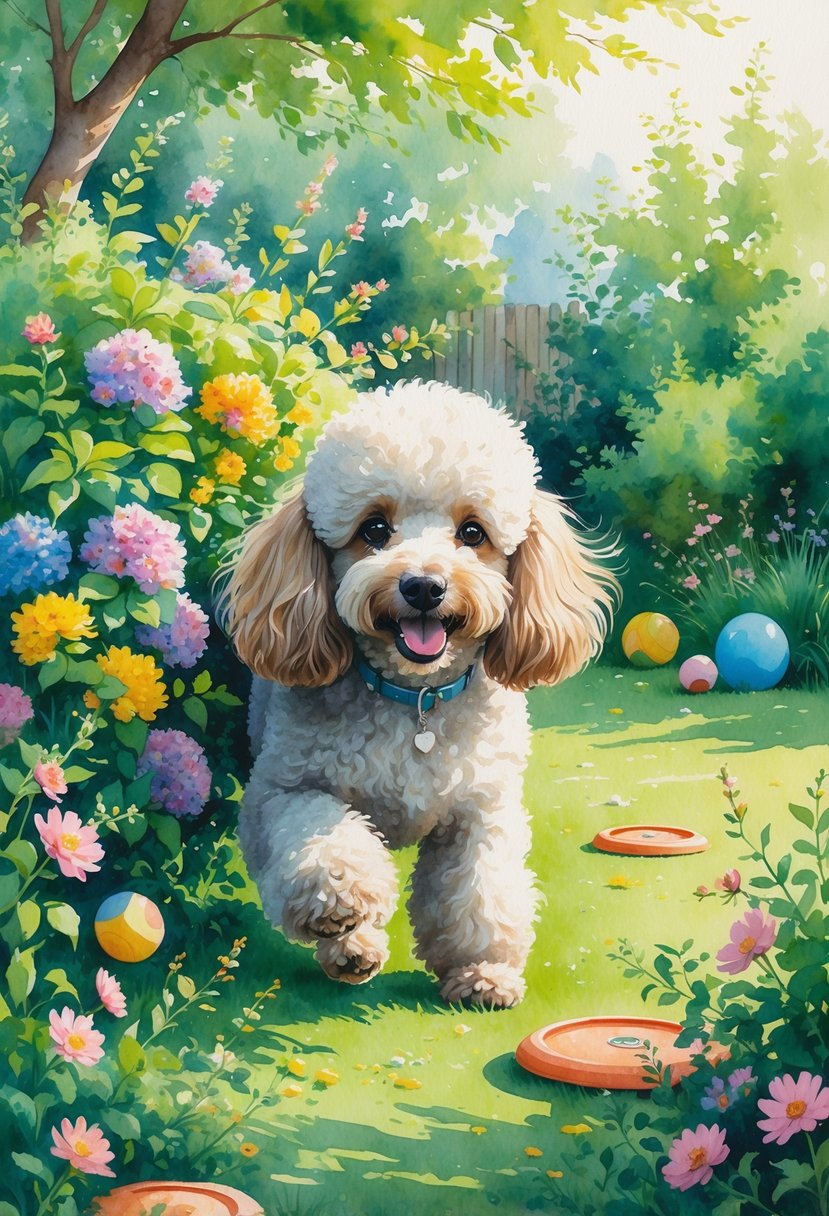
Hide and seek lets your poodle use their curiosity and problem-solving skills. It keeps them alert and strengthens recall in a simple, playful way.
How to Play Hide and Seek With Your Poodle
Ask your poodle to sit and stay in one room. Go hide somewhere else—behind a door, furniture, or under a blanket.
Once you’re hidden, call your dog’s name and wait for them to find you. When they do, reward them with praise, a treat, or a favorite toy.
If your poodle is new to the game, start with easy hiding spots. Make it harder as they catch on.
You can also hide toys or treats instead of yourself. This twist is great for practicing nose work.
Benefits for Mental Stimulation
Hide and seek sharpens your poodle’s memory and focus. They’ll listen for your voice, follow scent trails, and remember commands like stay and come.
The game helps fight off boredom. Even toy poodles need mental activity to stay happy.
Because it mixes play with training, hide and seek also boosts obedience. Each round reinforces listening skills.
Tips for Success With All Poodle Sizes
Adjust the game to fit your poodle. Toy poodles might like short distances and simple hiding spots. Standard poodles can handle bigger spaces and tougher searches.
Use clear commands like stay and come. Keep the sessions short to avoid frustration.
If your poodle gets stuck, give hints—make a noise or peek out. As they get better, up the challenge. Always end on a positive note.
Game 2: Find the Treat
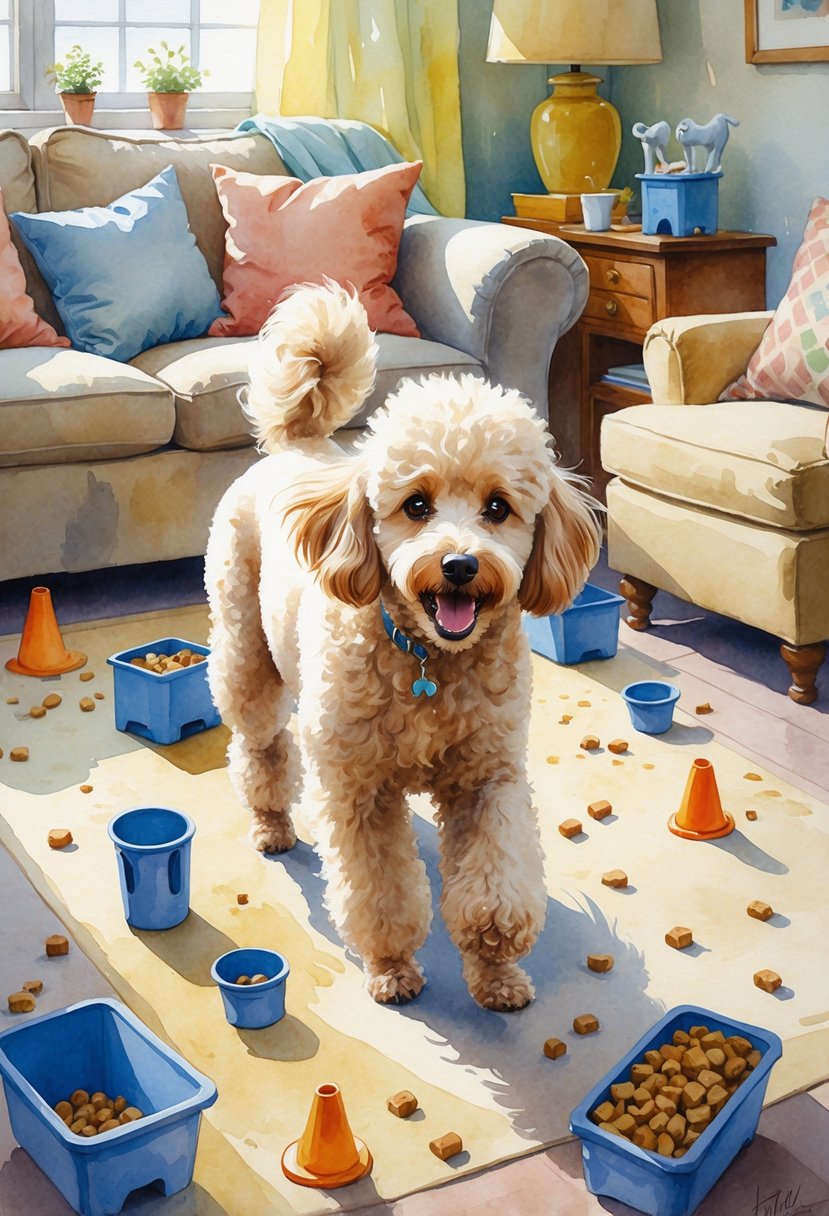
This game taps into your poodle’s scenting instincts. It keeps them focused while they work for a reward.
Setting Up a Scent Work Challenge
Grab a few treats your poodle loves. Place one under a cup or small container while your dog watches.
Encourage your dog to sniff it out and knock over the cup. Once they get it, add more cups and spread them out.
Always reward them right after they find the treat. You can use boxes, paper bags, or muffin tins with tennis balls to cover the treats.
Keep the first rounds easy. You want your poodle to feel confident and excited.
Increasing Difficulty for Advanced Poodles
If your poodle masters the basics, make things trickier. Hide treats in another room or behind objects.
Try smaller treats or containers with tiny holes to reduce the scent trail. Your dog will have to really use their nose.
You can wrap a treat in a towel or put it inside a puzzle toy. That way, your poodle has to work through each step.
Change up the hiding spots often. Surprises keep your dog engaged.
Game 3: Puzzle Toys and the Shell Game
Puzzle toys and the shell game are a blast for clever poodles. These activities let your dog figure things out and earn rewards.
Choosing the Right Puzzle Toys
Pick puzzle toys that suit your poodle’s size and chewing habits. If it’s too easy, they’ll get bored; too tough, and they’ll give up.
Look for treat-dispensing balls, sliding puzzles, or toys with hidden compartments. Many offer different difficulty levels.
Choose safe, durable materials like rubber or hard plastic. Poodles can be persistent, so you want something that lasts.
Swap out the toys every week or so. It keeps things interesting.
Playing the Shell Game at Home
The shell game is easy to set up. Just grab three cups and a few treats.
Place a treat under one cup while your poodle watches. Shuffle the cups slowly, then let your dog pick.
Start simple, then add more cups or shuffle faster as your poodle gets the hang of it.
The shell game builds focus and sharpens your dog’s problem-solving. It’s perfect for rainy days indoors.
Using Positive Reinforcement With Puzzles
Always pair puzzle success with rewards—treats, praise, or play. That way, your poodle connects effort with good things.
Give the treat right away so your dog knows what worked. A happy voice or a quick pet works too.
If your poodle gets stuck, help them out. Tap the right cup or show how the toy works. No need for scolding—keep it light and fun.
Game 4: Trick Training for Intelligent Poodles
Poodles love a good mental challenge. Trick training keeps their minds busy and brings you closer together.
Simple Tricks to Start With
Begin with easy tricks like sit, stay, and shake paw. These basics build confidence and focus.
Reward with treats or praise as soon as your dog gets it right. Keep sessions short—5 to 10 minutes is plenty.
Add in fun tricks like spin in a circle or lie down. Even simple tricks can give your dog a sense of accomplishment.
A quick training chart to get started:
| Trick | Cue Word | Reward Idea |
|---|---|---|
| Sit | “Sit” | Small treat |
| Paw | “Shake” | Praise + treat |
| Spin | “Spin” | Treat tossed on floor |
These basics lay the groundwork for more advanced tricks down the road.
Challenging Your Poodle With Advanced Tricks
Once your dog gets the basics down, you can start adding more complex behaviors. Try teaching roll over, play dead, or even fetching toys by name.
These tricks take patience, but your poodle will love the mental challenge. Break each advanced trick into smaller steps.
For roll over, reward lying down first, then shifting to the side, and finally a full roll. That way, your dog won’t get overwhelmed.
You can also teach practical tricks, like putting toys away in a basket. It’s a great mix of obedience and problem-solving—poodles really shine with stuff like this.
Game 5: Interactive Play Sessions
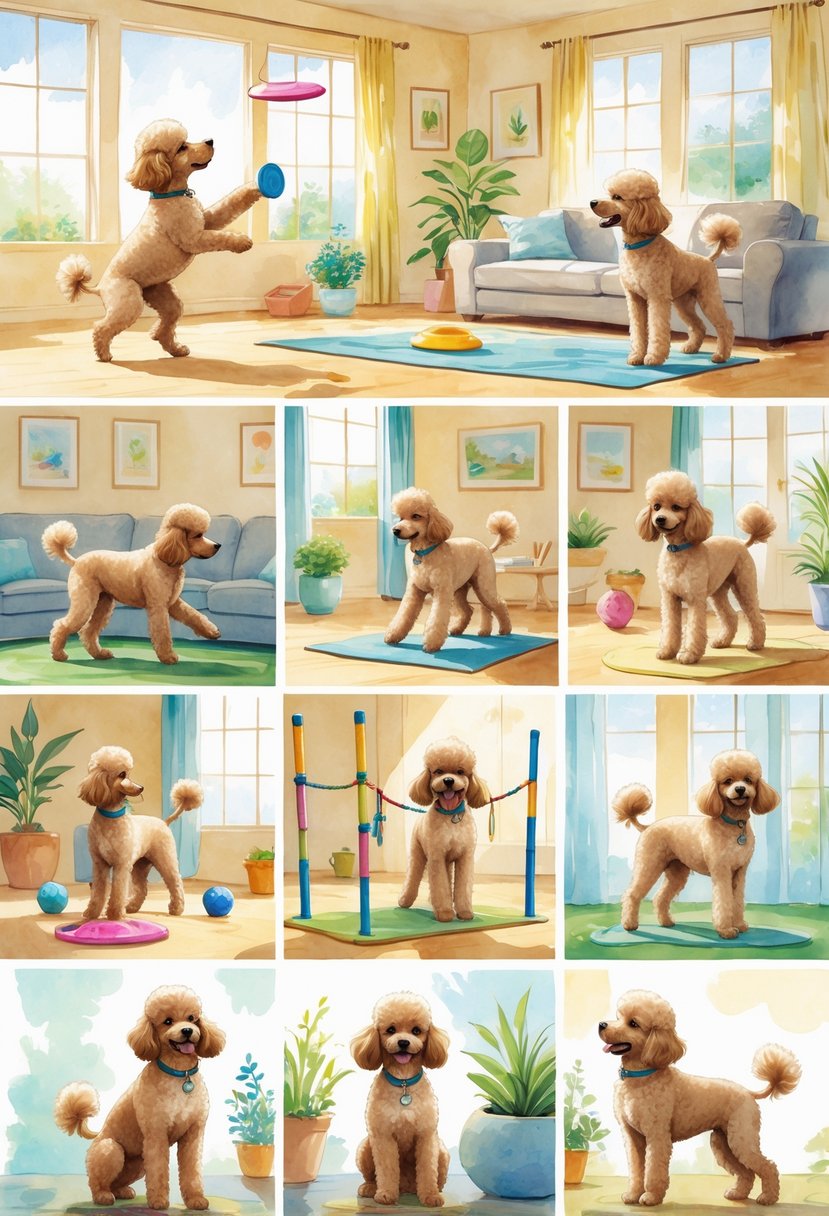
Interactive play keeps your poodle sharp and active. Toys and structured games can challenge their mind while letting them burn off energy.
Incorporating Toys for Extra Fun
Toys make interactive play more exciting for your poodle. Go for things like treat-dispensing balls or puzzle feeders—they encourage problem-solving and keep your dog busy.
Soft toys with squeakers can grab your poodle’s attention, too. Rotate toys often to keep things fresh.
Mix up textures—plush, rubber, rope—to keep playtime interesting. When you use fetch toys, try switching between a ball and a frisbee.
Each toy brings out different movements and keeps your dog guessing. For indoor play, stick with lightweight or soft toys so nothing gets broken.
Want to combine training and fun? Use toys that help reinforce commands like drop it or bring it. That way, your poodle is thinking and playing at the same time.
| Toy Type | Benefit | Example Use |
|---|---|---|
| Puzzle feeder | Mental stimulation | Hide kibble inside |
| Rope toy | Builds strength, tug play | Teach “drop it” |
| Frisbee/ball | Cardio, fetch-based exercise | Backyard or park sessions |
Games That Encourage Active Participation
Interactive play works best when your poodle feels involved. Games like hide and seek let them use their nose and brain to track you down.
You can also hide toys or treats around the room to spark curiosity. Tug of war is another good one—it builds confidence and teaches control if you set clear rules.
Keep the game light, and stop if your dog gets too rough. For small spaces, try the “find it” game.
Toss a treat a short distance and encourage your poodle to sniff it out. Make it harder by hiding treats under cups or boxes.
A flirt pole is another option—it mimics prey movement and keeps your dog chasing and jumping. Use it to practice commands like sit, stay, or leave it while they play.
Mixing up these activities means your dog isn’t just running—they’re thinking, too. That’s what makes interactive play so rewarding for poodles.
Game 6: Basic Obedience Games
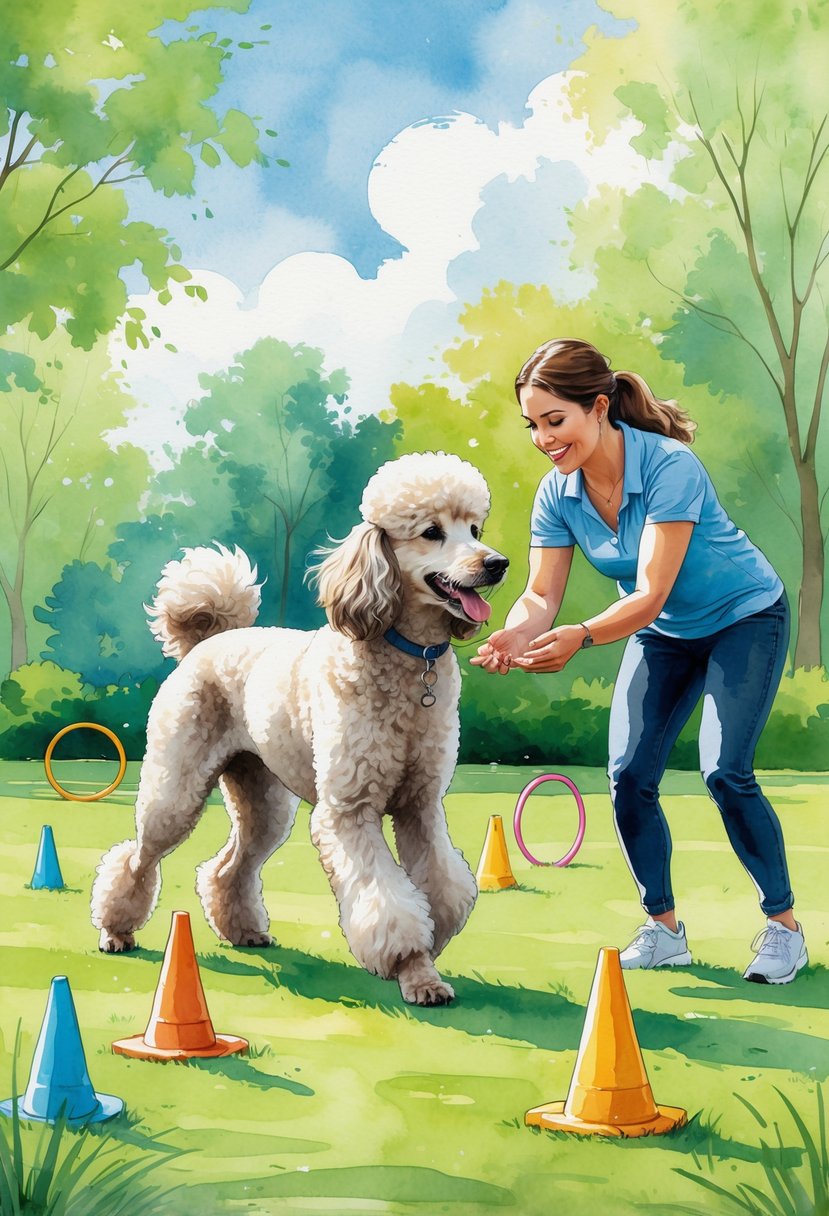
Basic obedience games give your poodle mental exercise and reinforce important commands. Turning training into play makes learning enjoyable and strengthens your bond.
Making Obedience Fun
Your poodle learns best when training feels like a game. Skip the long, repetitive drills—keep sessions short and playful.
Use treats, toys, or praise as rewards to keep motivation high. Mix commands into daily activities.
Ask for a sit before meals or a stay before opening the door. That way, obedience becomes part of your routine.
Throw in fun challenges to hold attention. Play “Simon Says” with commands like down or come—a little variety goes a long way.
Stop after a correct response so your dog looks forward to the next session.
Games That Reinforce Training
Games are a simple way to practice obedience and keep your poodle engaged. Try these:
- Hide and Seek: Call your poodle from another room to practice recall. Reward them when they find you.
- Recall Relay: Take turns with family members calling your dog back and forth. It strengthens the come command.
- Obstacle Mini-Course: Use chairs, cones, or boxes. Ask for sit, stay, and wait at different points.
- Name the Toy: Teach your poodle to fetch specific toys by name. It sharpens their listening skills.
These games combine movement, thinking, and obedience. They also build confidence as your poodle succeeds in small steps.
Game 7: Scent Work Adventures
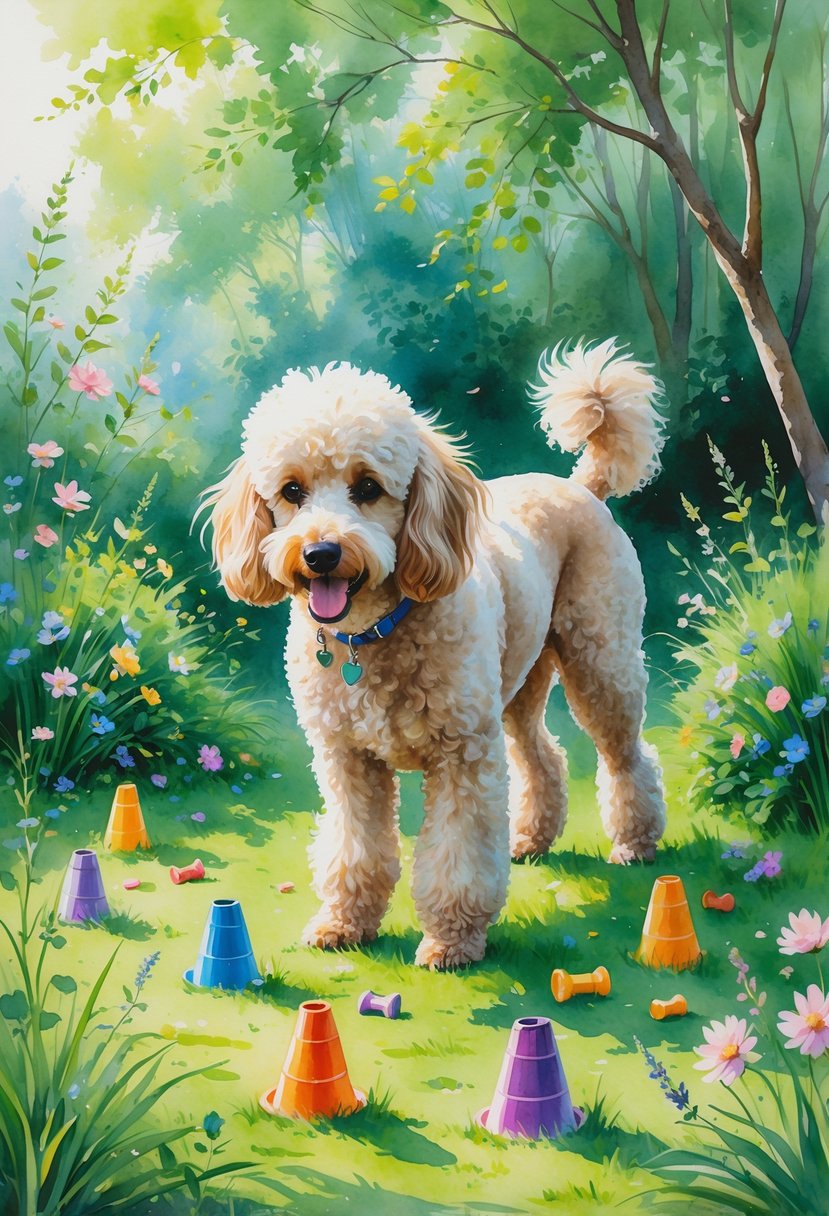
Scent work taps into your poodle’s natural urge to sniff and search. It keeps their mind sharp and gives them a fun job to focus on.
DIY Scent Trails at Home
You can set up simple scent trails at home with a few treats or toys. Start in one room and hide tiny bits of food in easy spots—under a chair, behind a cushion.
Use a cue word like “find it” to kick off the game. As your poodle gets better, make trails longer and more challenging.
Hide treats in trickier places, like inside a cardboard box or under a towel. That way, your dog has to use their nose more carefully.
Here’s a quick setup idea:
| Difficulty | Example Hiding Spot | Reward Type |
|---|---|---|
| Easy | On the floor corner | Small treat |
| Medium | Under cushion | Kibble |
| Hard | Inside box | Favorite toy |
Keep sessions short and positive. Always give your poodle praise when they succeed—not just food.
Outdoor Scent Games for Poodles
Taking scent work outside adds variety. Hide treats or toys in the yard, under leaves, or behind garden objects.
Use the same “find it” cue so your dog connects the activity indoors and out. Try dragging a treat bag along the ground to make a short scent trail, then leave it at the end.
Your poodle will follow the scent path to the reward. Other outdoor ideas:
- Hide and seek with toys: Hide a favorite ball in the grass.
- Tracking with clothing: Leave a sock or glove with your scent at the end of a trail.
- Station search: Set up several spots with different scented items.
Always keep an eye on your poodle during outdoor scent work. It keeps them safe and focused on you.
Tips for Maximizing Engagement and Success
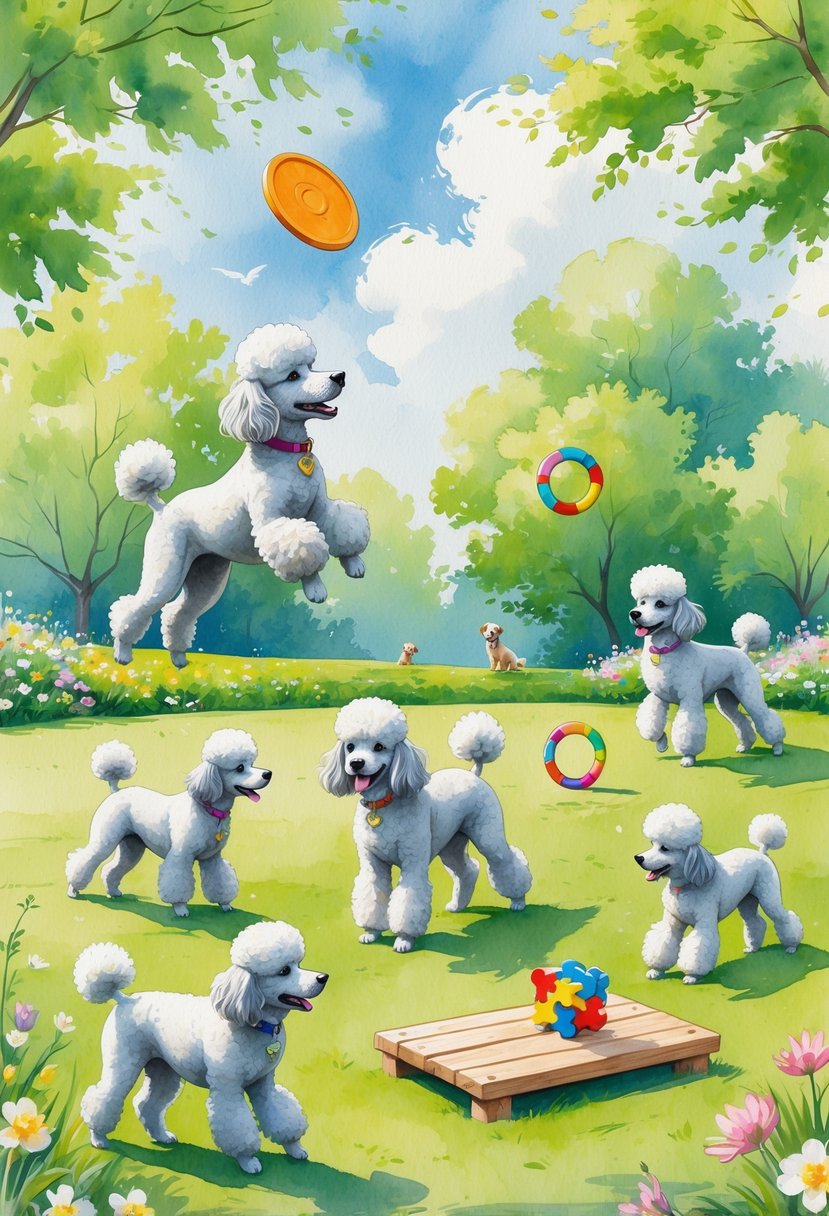
Keeping your poodle engaged takes variety, rewards, and adjusting activities to fit their size and energy. With the right approach, you can prevent boredom and build stronger habits.
Rotating Games to Prevent Boredom
Poodles are smart and get bored if they do the same thing all the time. Keep them motivated by rotating different games throughout the week.
Try puzzle toys one day, hide-and-seek the next, and maybe agility work later. Honestly, you don’t need a ton of activities.
Three to five games in rotation usually does the trick. Jot down a simple schedule so you remember to mix things up.
If your poodle seems restless or distracted, they might be tired of the routine. Switching things up can refresh their focus and help prevent unwanted behaviors.
Using Positive Reinforcement Effectively
Positive reinforcement works best when you reward your poodle right after they do what you want. Use small treats, lots of praise, or a favorite toy so they know they got it right.
Keep rewards small and frequent during training. That way, you won’t overfeed them but they’ll stay motivated.
If you’d rather not use too many treats, swap in praise or short play sessions as a reward. Be consistent with your cues and rewards.
Always use the same word or hand signal for a command. It helps your poodle connect the action with the reward, making training smoother for both of you.
Adapting Games for Toy, Miniature, and Standard Poodles
Each poodle size has its own quirks and needs. Toy poodles usually do best with shorter sessions and lighter toys.
Miniature poodles can handle more variety. Still, they might need breaks if activities go on too long.
Standard poodles often thrive with higher-energy games. Agility or scent trails seem to light them up.
Pick equipment that matches your dog’s size. Hurdles for a toy poodle should be very low, while a standard poodle can clear higher jumps without trouble.
Adjust the length of play, too. A toy poodle may only need 10 minutes of focused training.
A standard poodle might actually enjoy 20–30 minutes. Matching the activity to their size and stamina keeps things safe and fun.

